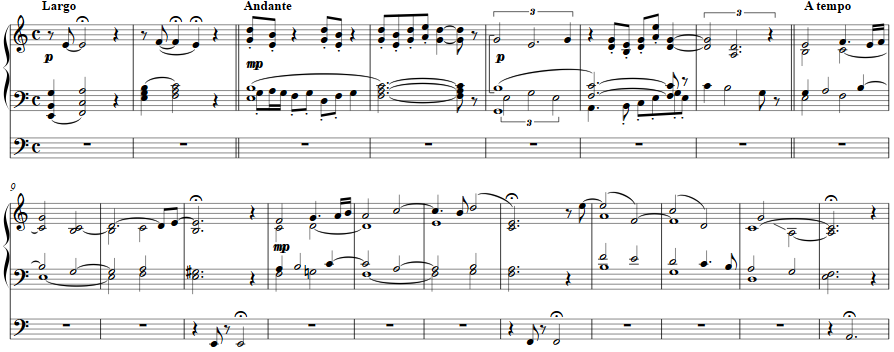Music and Texts of GARY BACHLUND
Vocal Music | Piano | Organ | Chamber Music | Orchestral | Articles and Commentary | Poems and Stories | Miscellany | FAQs
Essay on a Succession a Progression and Fugue - (2017)
for organ
for James Walker, master musician
James Walker, organist and choirmaster who has served All Saints Church, Pasadena, for 34 years retires this summer. Over the years as both organist and choirmaster he has performed some of my works there as well as in other venues.
Because I have know him since he was an adolescent when we performed Menotti's Amahl and the Night Visitors together, long before his role at All Saints, a little personal tribute to him seemed apt. Musing on the numbers three and four representing his 34 years of service, the association of these numbers fed musical thoughts. Schoenberg’s Structural Functions of Harmony, to which I still refer from time to time, makes a distinction between a succession of chords and a progression of chords. Schoenberg writes, "A triad standing alone is entirely indefinite in its harmonic meaning; it may be the tonic of one tonality or one degree of several others. A succession is aimless; a progression aims for a definite goal." The text continues in its clarification not apt for this note. A succession of three to four, numbers naming years of service, would yield iii to IV as one of a number of alternatives. Thus an overall scheme was suggested.
This "essay" states that harmonic succession, and then it is decorated with other materials in restatement. In like manner musing on three to four, the third of a triad when raised becomes a fourth in a diatonic scheme and then that can nest inside a iii to IV as internal voice leading most benign, as seen at the first a tempo. Then thinking on progressions made from a succession, a progression rooted on iii can become an answering progression built on IV, all the while 3 – 4 can also refer to triplets versus quadruplets, as well as alternating meters, 3/4 and 4/4 as is found in the fugue. From so many variants with which to invent, I whittled this little essay in honor of James' accomplishments over 34 years of service, and even longer friendship.
The fugue with its alternating meters, the reasoning as noted above, follows a short melodic bridge between the opening gestures and final 'movement.' The fugue subject at the outset is accompanied with a second voice as counterpoint, thereby placing the 3-4 in solidly its diatonic environment.
For more which musically link Walker and myself, there is an in memoriam to his teacher and my friend and colleague from years ago, Marcia Hannah Farmer, Cantabile semplice
from 2010, a number of choral works, and a work for organ, harpsichord and orchestra from 1997 performed at All Saints, a Concerto grosso in B major
.
8 pages, circa 8' 30" an MP3 demo is here:

The score is available as a free PDF download, though any major commercial performance or recording of the work is prohibited without prior arrangement with the composer. Click on the graphic below for this organ score.
Essay on a Succession a Progression and Fugue

